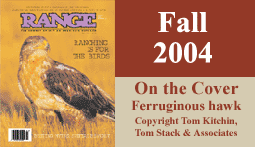

 |
 |
|
Up Front The sheep shouldn’t do what? . By C.J. Hadley Fred Fulstone called me last spring. I had taken three days off (first time in months) and he wanted me to come back to Nevada early. “I need you to go up in the Sierra Nevada with me, California Fish & Game, and the U.S. Forest Service. They want to cut my permit, throw me and my sheep off the Dunderberg Allotment. Their fisheries biologists want to explain why.” I’ve got huge affection for Fred. I like old men and he’s 84, been working on the land his whole life. He was supposed to be a doctor like his mother, but his dad fell ill and he came back from college to help run the big sheep outfit based in Smith, Nev. A dozen of us gathered north of Bridgeport in the early morning. We had a few rough miles to climb to the allotment. California Fish & Game (CFG) didn’t show up; neither did the fisheries biologist from the Forest Service. The experts in Lahontan cutthroat trout, the “endangered” species causing Fred and his neighboring sheepmen Paco and Miguel Iturirria pain, were supposed to explain why their permit was cut by a third and the sheep had to go. “They told me our sheep could drink from one short segment of Byday Creek,” Fred says with amazement, “and they could drink in the area only once.” The Iturirria brothers’ sheep could use another short segment of the same creek, and only once. The creek is eight miles long, a foot wide, unfenced, and, even by unrealistic Forest Service standards, healthy. How do you keep a few thousand sheep and lambs from straying from the narrow boundaries? And why? Even though CFG have planted Lahontan cutthroat trout in the lower end of Byday Creek many times over the past decade, none seem to like living in it. “Those fish are not here,” Fred says. “Our sheepherders have never seen any.” The ranchers have also been thrown off because of desert bighorn sheep (see Tim Findley’s story, p. 56). Some bighorns were transplanted to Lee Vining Canyon by CFG to use as reintroduced herds for areas farther south. State and federal biologists, encouraged by U.S. Fish & Wildlife Service agents, say they are traveling toward Dunderberg and want to make sure Fulstone’s domestic sheep don’t get in their way. “We’ve never seen any bighorns on our allotments either, because they have never been there,” Fred says. “Virginia Lakes Pack Station has been taking dudes into these mountains for a long, long time. They have never seen bighorns and haven’t seen any sign. Why are they doing this to us?” Of the three women from the Forest Service who did show up, the wildlife biologist was asked about the Lahontan cutthroat trout. “I don’t know anything about fish,” she giggled. Another Forest Service bureaucrat admitted she was there, “to report on what’s said here.” Why? Were they expecting a backlash? The young range specialist admitted she’d only set foot on the allotment twice. Fred has been there several times a year for decades—his sheepherders live up there for months—and it still looks good. Maybe the solution could be to follow New Zealand’s example and throw out most state and federal agencies. The U.S. Forest Service, California Fish & Game and the U.S. Fish & Wildlife Service should be first. C.J. Hadley is editor/publisher of RANGE magazine, which she created in 1991. .
|
|
|
|
|
|
© 1998-2005 RANGE magazine. All rights reserved. | For reprints, permissions or general questions, contact |
|
Brought to you by Dolphin Enterprises |